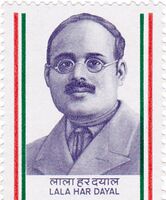Har Dayal
Dayal, H.
| PersonType | Category:Authors of English Works Category:Independent Researchers |
|---|---|
| FirstName / namefirst | Har |
| LastName / namelast | Dayal |
| MainNamePhon | Har Dayal |
| SortName | Dayal, Har |
| bio | Lala Har Dayal Singh Mathur (Punjabi: ਲਾਲਾ ਹਰਦਿਆਲ; 14 October 1884 – 4 March 1939) was an Indian nationalist revolutionary and freedom fighter. He was a polymath who turned down a career in the Indian Civil Service. His simple living and intellectual acumen inspired many expatriate Indians living in Canada and the U.S. to fight against British Imperialism during the First World War.
Har Dayal Mathur was born in a Hindu Mathur Kayastha family on 14 October 1884 at Delhi. He was the sixth of seven children of Bholi Rani and Gauri Dayal Mathur. His father was a district court reader. Lala is not so much a surname as a sub-caste designation, within the Kayastha community, but it is generally termed as an honorific title for writers such as the word Pandit which is used for knowledgeable persons in other Hindu communities. At an early age, he was influenced by Arya Samaj. He was associated with Shyam Krishnavarma, Vinayak Damodar Savarkar and Bhikaji Cama. He also drew inspiration from Giuseppe Mazzini, Karl Marx and Mikhail Bakunin. He was, according to Emily Brown as quoted by Juergensmeyer, "in sequence an atheist, a revolutionary, a Buddhist, and a pacifist". He studied at the Cambridge Mission School and received his bachelor's degree in Sanskrit from St. Stephen's College, Delhi, India and his master's degree also in Sanskrit from Punjab University. In 1905, he received two scholarships of Oxford University for his higher studies in Sanskrit: Boden Scholarship, 1907 and Casberd Exhibitioner, an award from St John's College, where he was studying. In a letter to The Indian Sociologist, published in 1907, he started to explore anarchist ideas, arguing that "our object is not to reform government, but to reform it away, leaving, if necessary only nominal traces of its existence." The letter led to him being put under surveillance by the police. Later that year, saying "To Hell with the ICS", he gave up the prestigious Oxford scholarships and returned to India in 1908 to live a life of austerity. But in India too, he started writing harsh articles in the leading newspapers, When the British Government decided to impose a ban upon his writing Lala Lajpat Rai advised him to leave and go abroad. It was during this period that he came into the friendship of the anarchist Guy Aldred, who was put on trial for printing The Indian Sociologist. Among his many literary works include The Bodhisattva Doctrines in Buddhist Sanskrit Literature. Lala Lajpat Rai, who was a mentor of Har Dayal, had suggested him to write an authentic book based on the principles of Gautam Buddha. In 1927 when Har Dayal was not given permission by the British Government to return to India, he decided to remain in London. He wrote this book and presented it to the University as a thesis. The book was approved for Ph.D. and a Doctorate was awarded to him in 1932. It was published from London in the year 1932. Motilal Banarsidass Publishers of India re-published this book in 1970 as The Bodhisattva Doctrines in Buddhist Sanskrit Literature. This 392-page work of Lala Hardayal consists of 7 chapters which deal with the Bodhisattva doctrine as expounded in the principal Buddhist Sanskrit Literature.
This book contains comprehensive notes and references besides a general index appended at the end. This book has been written in a particularly lucid style which exhibits scholarly acumen and the mastery of Lala Hardayal in literary art. It proved influential with Edward Conze, a German Marxist refugee from Nazi Germany who made Har Dayal 's acquaintance in London in the 1930's. (Adapted from Source Mar 26, 2021) |
| YearBirth | 1884/10/14 |
| YearDeath | 1939/03/04 |
| education | M.A. in Sanskrit, Punjab University
B.A. in Sanskrit, St. Stephen's College, Delhi |
| IsInGyatsa | No |
| Other wikis |
If the page does not yet exist on the remote wiki, you can paste the tag |

